Confronted by disappointing sales and the common knowledge that it does little that hasn’t already been offered or archieved under Unix, ibm has clearly decided to devote time and energy to hyping its OS/2 operating system. Two of the conpany’s US-based executives were recently summoned to IBM’s South Bank offices where, undeterred by a fire drill, they energetically outlined the multiple benefits of the product to a group of assembled sceptics. To date, the range comprises the Standard Edition 1.0, released in the December of last year, the Extended Edition 1.0, available in the US since the end of July, the Standard Edition 1.1, due for release at the end of November. Naturally, most comparisons were restricted to a superior – than – PC-DOS – type format, particularly the breaking of the so-called640 Kb memory barrier, achieved by integrating a memory management component to the Standard Edition 1.0 or base version of the operating system.
Very large applications Users now have, so the corporate argument goes, up to 16 Mb of memory support, enabling them to develop and run spreadsheets and other very large applications, together with significant multi-tasking capabilities. For the recently arrived Extended Edition 1.0, IBM has effectively stucked the Communications Manager and Database Manager subsystems to the base operating system. The rationale behind this appears to be internally conducted and IDC research, which suggests that by1992, some 95% of all business personal computers worldwide will be communicating, and that 75% of the same group will have some form of database attached. Currently enabling communication with a number of differnt kinds of processors thecompany claims that within Extended Edition 1.1, the Communications Manager will provide users with a distributed applications base, the ability to conduct up to 25 concurrent communications session and extensive mix and match connectivity. Broken down to specifics the connectivity extends to Advanced Program-toProgram Communications using Logical Unit 6.2 and Physical Unit 2.1 protocols; a 3270 and Server-Requester Program Interface supporting up to 10 concurrent LU6.2 sessions; a move towards the IEEE 802.3 Ethernet standard coupled with support for NetBIOS within the local area networking arena; an Asynchronous Communications Device Interface to support three concurrent asynchronous sessions, and an Asynchronous EM facility, apparently provided to meet user demand for an entry level to the asynchronous environment. Planned enhancements, which IBM insists will materialise in less than a year, are the 5250 WSF WorkStation Facility, and X25 packet switching. And the Communications Manager within the December release will also include a LAN Requester Support facility. IBM claims that, on top of supporting all the requester functions provided by release 1.3 of the PC LAN Program, the subsystem can act as a remote network administrator: by defining user profiles, it eliminates the need for a dedicated administrator terminal. IBM also argues that by allowing the requestor code to reside on the same network as the LAN Program, it has provided users with a gradual OS/2 migration path. An optional – if crucial communications package comes in the form of the LAN Server function. In addition to providing security for relational and flat file data, the server can support eight concurrent printers per PS/2, and offers what the company describes as remote program execution. Essentially, the server can be used to execute a software program, while redirecting the input-output back to the requester: meanwhile, the profiling capacity of the LAN Program ensures that theuser limits are observed. A similar breakdown was provided for the Database Management subsystem. While a database engine-style component provides a complete range of SQL-based data management services – roll back, full commit, auto-restart and data deadlock resolution tools – an optional Query Manager component offers three application enabling interfaces. One designed for the experienced
SQL user is complemented by the Prompted Query interface which employs crude artificial intelligence techniques to enable non-computer people to create a database, while a third uses command lines to reduce development time and expand productivity. Final component of the 1.1 Extended Edition is Presentation Manager, which provides windowing, graphics and clipboard functions, and, via its specification within the Common User Interface, a theoretical link to Systems Application Architecture. Technical details aside, considerable time was spent explaining how the operating system would be expanded to meet user demands in the future.A predicted growth in graphics, image, and voice data, requiring the transfer and access of around 200,000 bytes per screen, will, it says, be met by a move to a 32-bit base, the provision of a maximum 4Gb of memory, and the exploitation of Micro Channel Architecture. Named Pipes On the performance front, eventual transfer rates of 3.6Mbps were citted alongside 255 concurrent input-output tasks while within the crucial networking sphere, Named Pipes documentation is there but – as yet – unavailable, with less than six months the figure bandied around for the provision of a single 16Mb backbone card for linking multiple workgroups. Similarly, with additional card intelligence, a 16Mbps Token Ring protocol will eventually allow for Early Token Release – the ability to place multiple messages on the ring concurrently – while support for the Systems Network Architecture LAN Gateway was placed into the less-than-a-year planned enhancement category. In directional terms, the short term future of OS/2 was described as the provision of remote data services – the ability to divide, without changing aline of code, single stand-alone programs over a network, while still maintaining full database-style integrity. Long-term, the operating system is expected to play a vital role in creating a distributed data environment – effectively, the distribution of a database across a Systems Application Architecture network. And applications? A list of 22 software vendors was quickly flashed up to prove that work on modern – that is larger, artificial intelligence-based – applications was well under way. In a long term mode however, and having claimed that with Extended Edition 1.1, it had provided application developers with quantum leap tools, the company chose to play self-effacing: the capabilities would, it felt sure, provide for a range of applications we haven’t even thought of yet.






